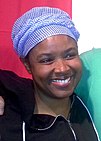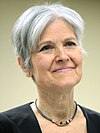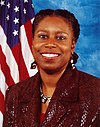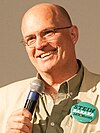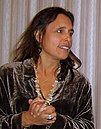Green Party Of The United States
The Green Party of the United States (GPUS) is a federation of Green state political parties in the United States.
The party promotes green politics, specifically environmentalism; nonviolence; social justice; participatory democracy; grassroots democracy; anti-war; anti-racism; eco-socialism. On the political spectrum, the party is generally seen as left-wing. As of 2023,[update] it is the fourth-largest political party in the United States by voter registration, behind the Libertarian Party.
Green Party of the United States | |
|---|---|
 | |
| Co-chairs | |
| Governing body | Green National Committee |
| Founders | Howie Hawkins John Rensenbrink |
| Founded | April 2001 |
| Split from | Greens/Green Party USA |
| Preceded by | Association of State Green Parties |
| Headquarters | 6411 Orchard Avenue, Suite 101, Takoma Park, Maryland 20912 |
| Newspaper | Green Pages |
| Youth wing | Young Ecosocialists |
| Women's wing | National Women's Caucus |
| LGBTQIA+ wing | Lavender Greens |
| Latino and Hispanic wing | Latinx Caucus |
| Black wing | National Black Caucus |
| Membership (2023) | |
| Ideology | |
| Political position | Left-wing |
| Regional affiliation | São Paulo Forum (applicant) |
| Continental affiliation | Federation of the Green Parties of the Americas |
| International affiliation | Global Greens (associate member) |
| Colors | Green |
| Seats in the Senate | 0 / 100 |
| Seats in the House of Representatives | 0 / 435 |
| State governorships | 0 / 50 |
| Seats in state upper chambers | 0 / 1,972 |
| Seats in state lower chambers | 0 / 5,411 |
| Territorial governorships | 0 / 5 |
| Seats in territorial upper chambers | 0 / 97 |
| Seats in territorial lower chambers | 0 / 91 |
| Other elected officials | 144 (February 2024)[update] |
| Election symbol | |
 | |
| Website | |
| www | |
The direct predecessor of the GPUS was the Association of State Green Parties (ASGP). In the late 1990s, the ASGP, which formed in 1996, had increasingly distanced itself from the Greens/Green Party USA (G/GPUSA), America's then-primary green organization which had formed in 1991 out of the Green Committees of Correspondence (CoC), a collection of local green groups active since 1984. In 2001, the GPUS was officially founded as the ASGP split from the G/GPUSA. After its founding, the GPUS soon became the primary national green organization in the country, surpassing the G/GPUSA. John Rensenbrink and Howie Hawkins were co-founders of the Green Party.
The Greens (as ASGP) first gained widespread public attention during the 2000 presidential election, when the ticket composed of Ralph Nader and Winona LaDuke won 2.7% of the popular vote, raising questions as to whether they spoiled the election in favor of George W. Bush. Nader has dismissed the notion that he and other Green candidates are spoilers.
History
Early years
The political movement that began in 1985 as the decentralized Committees of Correspondence evolved into a more centralized structure by 1990, opening a national clearinghouse and forming governing bodies, bylaws and a platform as the Green Committees of Correspondence (GCoC) and by 1990 simply The Greens. The organization conducted grassroots organizing efforts, educational activities and electoral campaigns.
Internal divisions arose between members who saw electoral politics as ultimately corrupting and supported the notion of an "anti-party party" formed by Petra Kelly and other leaders of the Greens in Germany vs. those who saw electoral strategies as a crucial engine of social change. A struggle for the direction of the organization culminated in a "compromise agreement", ratified in 1990 at the Greens National Congress in Elkins, West Virginia and in which both strategies would be accommodated within the same 527 political organization renamed the Greens/Green Party USA (G/GPUSA). It was recognized by the FEC as a national political party in 1991.
The compromise agreement subsequently collapsed and two Green Party organizations co-existed in the United States until 2019 when the Greens/Green Party USA was dissolved. The Green Politics Network was organized in 1990 and the National Association of Statewide Green Parties formed by 1994. Divisions between those pressing to break onto the national political stage and those aiming to grow roots at the local level continued to widen during the 1990s. The Association of State Green Parties (ASGP) encouraged and backed Nader's presidential runs in 1996 and 2000. By 2001, the push to separate electoral activity from the G/GPUSA issue-based organizing led to the Boston Proposal and the subsequent rise of the Green Party of the United States. The G/GPUSA lost most of its affiliates in the next few months and dropped its FEC national party status in the year 2005.
Ideology
Values
The Green Party of the United States follows the ideals of green politics, which are based on the Four Pillars, namely:
The Ten Key Values, which expand upon the Four Pillars, are as follows:
- Grassroots democracy,
- Social justice and equal opportunity,
- Ecological wisdom,
- Nonviolence,
- Decentralization,
- Community-based economics,
- Feminism and gender equality,
- Respect for diversity,
- Personal and global responsibility, and
- Future focus and sustainability.
The Green Party doesn't accept donations from corporations, political action committees (PACs), 527(c) organizations or soft money. The party's platforms and rhetoric harshly criticize corporate influence and control over government, media, and society at large.
Eco-socialism
In 2016, the Green Party passed a motion in favor of rejecting both capitalism and state socialism, supporting instead an "alternative economic system based on ecology and decentralization of power". The motion states the change that the party says could be described as promoting "ecological socialism", "communalism", or perhaps the "cooperative commonwealth". The Green Party rejection of both state socialism and capitalism and their promotion of communalism which was created by libertarian socialist Murray Bookchin places the Green Party into the ideology of libertarian socialism. The eco-socialist economy the Green Party of the United States wants to create is similar to the market socialist mutualist economics of Proudhon which consists of a large sector of democratically controlled public enterprises, a large sector of cooperative enterprises, and a smaller sector of small businesses and self-employed. Consumer goods and services would be sold to consumers in the market by cooperatives, public enterprises, and small businesses. Services that would be for free include health care, education, child care, and urban mass transit. Goods and services that would be available at low cost would include public housing, power, broadband, and water. The party will also create cooperative banks offering low interest somewhat similar to Proudhon's Mutualist banks. Howie Hawkins who was nominated by the Green Party to run for president of the United States in 2020 identifies as a libertarian socialist.
Political positions
Economic and social issues
Healthcare
The Green Party supports the implementation of a single-payer healthcare system and the abolition of private health insurance in the United States. They have also called for contraception and abortion procedures to be available on demand. The Green Party has called for the repeal of the Hyde Amendment, an act that prohibits the use of federal taxpayer funds for abortions, unless in the cases of rape, incest, or to save the life of the mother.
Education
The Green Party calls for providing tuition-free college at public universities and vocational schools, increasing funding for after-school and daycare programs, cancelling all student loan debt, and repealing the No Child Left Behind Act. They are strongly against the dissolution of public schools and the privatization of education.
Green New Deal
In 2006, the Green Party developed a Green New Deal that would ultimately serve as a transitional plan to a 100% clean, renewable energy including solar and wind energy by 2030 utilizing a carbon tax, jobs guarantee, tuition-free college, single-payer healthcare and a focus on using public programs.
Howie Hawkins focused his gubernatorial campaign on the Green New Deal, which was the first time the policy was introduced. Jill Stein also developed her presidential campaign based on the Green New Deal.
Criminal justice
The Green Party favors the abolition of the death penalty, repeal of three-strikes laws, banning of private prisons, legalization of marijuana, and decriminalization of other drugs.
Racial justice
The Green Party advocates for "complete and full" reparations to the African American community, as well the removal of the Confederate flag from all government buildings.
LGBT+ rights
The party supports same-sex marriage, the right of access to medical and surgical treatment for transgender and gender-nonconforming people, and withdrawing foreign aid to countries with poor LGBT+ rights records. The party opposes gender-critical feminism.
Youth rights
The party supports youth rights. They reject the idea that young people are property of their parents or guardians. They support providing mothers with prenatal care. They oppose child abuse and neglect and support young people's rights to food, shelter, healthcare, and education. They support greater student input into their education and sex education and oppose advertisements in schools. They support lowering the voting age to 16.
Fundraising and position on Super PACs
In the early decades of Green organizing in the United States, the prevailing American system of money-dominated elections was universally rejected by Greens, so that some Greens were reluctant to have Greens participate in the election system at all because they deemed the campaign finance system inherently corrupt. Other Greens felt strongly that the Green Party should develop in the electoral arena and many of these Greens felt that adopting an alternative model of campaign finance, emphasizing self-imposed contribution limits, would present a wholesome and attractive contrast to the odious campaign finance practices of the money-dominated major parties.[citation needed]
Over the years, some state Green parties have come to place less emphasis on the principle of self-imposed limits than they did in the past. Nevertheless, it is safe to say that Green Party fundraising (for candidates' campaigns and for the party itself) still tends to rely on relatively small contributions and that Greens generally decry not only the rise of the Super PACs, but also the big-money system, which some Greens criticize as plutocracy.[citation needed]
Some Greens feel that the Green Party's position should be simply to follow the laws and regulations of campaign finance. Other Greens argue that it would injure the Green Party not to practice a principled stand against the anti-democratic influence of money in the political process. Candidates for office, like Jill Stein, the 2012 and 2016 Green Party nominee for the President of the United States, typically rely on smaller donations to fund their campaigns.[citation needed]
Foreign policy
The Green Party calls on the United States to join the International Criminal Court, and sign the Comprehensive Nuclear-Test-Ban Treaty and Non-Proliferation Treaty. Additionally, it supports cutting the defense budget in half, as well as prohibiting all arms sales to foreign countries.
Iran
The Green Party supports the 2015 Iran nuclear deal to decrease sanctions while limiting Iran's capacity to make nuclear weapons.
Israel/Palestine
The Green Party advocates for the Palestinian right of return and cutting all U.S. aid to Israel. It has also expressed support for the Boycott, Divestment and Sanctions (BDS) movement. The Green Party supports "...the creation of one secular, democratic state for Palestinians and Israelis on the land between the Mediterranean Sea and the River Jordan as the national home of both peoples, with Jerusalem as its capital."
The Green Party called for a ceasefire in the Israel–Hamas war and condemned Israeli war crimes in the Gaza Strip.
Criticism and controversies
"Playing spoiler"
Some political analysts argue that the party's tickets have resulted in elections being spoiled for the Democratic Party, with Republican candidates winning – most notably George W. Bush's defeat of Al Gore in 2000 and Donald Trump's victory in 2016. In 2019, former Green presidential candidate Ralph Nader told The Washingtonian that, while he still does not consider himself a spoiler, he regretted not entering the 2000 Democratic primary. A 2020 The New York Times article highlighted previous efforts by members of the Republican Party to use the Green Party to spoil elections in their party's favor.
Russia
The United States Senate's probe into Russian election interference investigated Jill Stein and the Green Party for potential collusion and looked to better understand why and how Russia was promoting the party. Politico and Newsweek reported that Russian state actors covertly promoted Stein and other Green Party candidates on Facebook prior to the 2016 elections. NBC News reported that a "growing body of evidence [exists] that [shows] the Russians worked to boost the Stein campaign as part of the effort to siphon support away from Democratic candidate Hillary Clinton and tilt the election to Trump." NBC News additionally documented over 100 instances where Stein appeared on Russian state media, receiving favorable coverage. In 2015, Stein was photographed dining at the same table as Russian president Vladimir Putin at the RT 10th anniversary gala in Moscow, leading to further controversy. Stein contended that she had no contact with Putin at the dinner and described the situation as a "non-event".
Stein's 2016 foreign policy positions regarding Russian topics have been considered by some to have mirrored those of the Russian government, in some instances, including concerning the annexation of Crimea. Stein condemned Russia's 2022 invasion of Ukraine, but claimed that Russia was provoked by NATO's eastward expansion.
Allegations of irregularities in primary elections
On October 16, 2019, a joint candidate letter called for reform in the Green Party's presidential primary process in response to the party's announcement that it would remove unrecognized candidates from its website list that November, an effort which Green candidates claimed was being to done to help the Hawkins campaign secure the party's nomination. This was followed by allegations of conflicts of interest among the party's leadership, members of which the candidates believed were helping party co-founder Howie Hawkins, and of an alleged overlooking of a violation of Green Party rules that would have disqualified Hawkins from running as a Green, due to him also seeking the Socialist Party's nomination.
After the 2020 Green Party Nominating Convention named Hawkins as their presidential candidate, runner-up Dario Hunter announced via Twitter that he would continue to pursue the presidency as an independent candidate. Hunter cited alleged irregularities and undemocratic processes throughout the Green Party presidential primary, stating that party leaders had committed “ethical lapses” to ensure Hawkins nomination, and criticizing Hawkins for what he saw as his "imperialist perspective" and "CIA talking points.”
Structure and composition
Committees
The Green Party has two national committees recognized by the Federal Election Commission (FEC):
- The Green National Committee (GNC)
- The Green Senatorial Campaign Committee (GSCC)
Green National Committee
The GNC is composed of delegates elected by affiliated state parties. The state parties also appoint delegates to serve on the various standing committees of the GNC. The National Committee elects a steering committee of seven co-chairs, a secretary and a treasurer to oversee daily operations. The National Committee performs most of its business online, but it also holds an annual national meeting to conduct business in person.
Caucuses
Five Identity Caucuses have achieved representation on the GNC:
- National Black Caucus
- Latinx Caucus
- Lavender Greens Caucus (LGBTQIA+)
- National Women's Caucus
- Young Ecosocialists
Other caucuses have worked toward formal recognition by the GNC:
- Disability Caucus
- Labor Caucus
- Indigenous Caucus
- Elder Caucus
Membership
| Party | Percentage (2022) |
|---|---|
| Democratic | 38.73% |
| Republican | 29.6% |
| Libertarian | 0.6% |
| Green | 0.19% |
| Constitution | 0.11% |
The Green Party's membership encompasses the fourth-highest percentage of registered voters in the United States, with a total membership of 234,120. The Green Party has its strongest popular support on the Pacific Coast, Upper Great Lakes, and Northeast, as reflected in the geographical distribution of Green candidates elected. As of June 2007[update], Californians have elected 55 of the 226 office-holding Greens nationwide. Other states with high numbers of Green elected officials include Pennsylvania (31), Wisconsin (23), Massachusetts (18) and Maine (17). Maine has the highest per capita number of Green elected officials in the country and the largest Green registration percentage with more than 29,273 Greens comprising 2.95% of the electorate as of November 2006[update]. Madison, Wisconsin is the city with the most Green elected officials (8), followed by Portland, Maine (7).

The 2016 presidential campaign of Jill Stein got substantive support from counties and precincts with a high percentage of Native American population. For instance, in Sioux County (North Dakota, 84.1% Native American), Stein gained her best county-wide result: 10.4% of the votes. In Rolette County (also North Dakota, 77% Native American), she got 4.7% of the votes. Other majority Native American counties where Stein did above state average are Menominee (WI), Roosevelt (MT) and several precincts in Alaska.
At its peak in 2004, the Green Party had 319,000 registered members in states allowing party registration and tens of thousands of members and contributors in the rest of the country.
State and territorial parties
The following is a list of accredited state parties which comprise the Green Party of the United States.
Green Party of Alaska- Disaffiliated since January 12, 2021 due to nominating Jesse Ventura as its presidential candidate for the 2020 United States presidential election.
- Arizona Green Party
- Green Party of Arkansas
- Green Party of California
- Green Party of Colorado
- Connecticut Green Party
- Green Party of Delaware
- D.C. Statehood Green Party
- Green Party of Florida
Green Party of Georgia- Deaccredited on July 26, 2021, due to the adoption of the Declaration on Women's sex-based rights in its party platform.
- Green Party of Montana
- Green Party of Hawaii
- Idaho Green Party
- Illinois Green Party
- Indiana Green Party
- Iowa Green Party
- Kansas Green Party
- Kentucky Green Party
- Green Party of Louisiana
- Maine Green Independent Party
- Maryland Green Party
- Green-Rainbow Party (Massachusetts)
- Green Party of Michigan
- Green Party of Minnesota
- Green Party of Mississippi
- Green Party of New York
- Nebraska Green Party
- Green Party of New Jersey
- North Carolina Green Party
- Green Party of Ohio
- Green Party of Oklahoma
- Pacific Green Party (Oregon)
- Green Party of Pennsylvania
Green Party of Rhode Island- Disaffiliated since December 29, 2020 due to endorsing Joe Biden for president during the 2020 United States presidential election.
- South Carolina Green Party
- Green Party of Texas
- Green Party of Utah
- Vermont Green Party
- Green Party of Virginia
- Green Party of Washington State
- Mountain Party (West Virginia)
- Wisconsin Green Party
List of national conventions and annual meetings
The Green National Convention is scheduled in presidential election years and the Annual National Meeting is scheduled in other years. The Green National Committee conducts business online between these in-person meetings.
- 1996 – Los Angeles, California
- 2000 – Denver, Colorado
- 2001 – Santa Barbara, California
- 2002 – Philadelphia, Pennsylvania
- 2003 – Washington, D.C.
- 2004 – Milwaukee, Wisconsin
- 2005 – Tulsa, Oklahoma
- 2006 – Tucson, Arizona
- 2007 – Reading, Pennsylvania
- 2008 – Chicago, Illinois
- 2009 – Durham, North Carolina
- 2010 – Detroit, Michigan
- 2011 – Alfred, New York
- 2012 – Baltimore, Maryland
- 2013 – Iowa City, Iowa
- 2014 – Saint Paul, Minnesota
- 2015 – St. Louis, Missouri
- 2016 – Houston, Texas
- 2017 – Newark, New Jersey
- 2018 – Salt Lake City, Utah
- 2019 – Salem, Massachusetts
- 2020 – Virtual Online (originally planned for Detroit, Michigan prior to COVID-19 pandemic)
Officeholders



As of November 2022[update], 136 officeholders in the United States were affiliated with the Green Party. The party has not had any representation in federal or statewide offices.
Previously in 2016, the majority of them were in California, several in Illinois, Connecticut, Maine, Massachusetts, Oregon, Pennsylvania, and Wisconsin, with five or fewer in ten other states. These included one mayor and one deputy mayor and fourteen county or city commissioners (or equivalent). The remainder were members of school boards, clerks and other local administrative bodies and positions.
Several Green Party members have been elected to state-level office, though not always as affiliates of the party. John Eder was elected to the Maine House of Representatives, re-elected in 2004, but defeated in 2006. Audie Bock was elected to the California State Assembly in 1999, but switched her registration to independent seven months later running as such in the 2000 election. Richard Carroll was elected to the Arkansas House of Representatives in 2008, but switched parties to become a Democrat five months after his election. Fred Smith was elected to the Arkansas House of Representatives in 2012, but re-registered as a Democrat in 2014. In 2010, former Green Party leader Ben Chipman was elected to the Maine House of Representatives as an unenrolled candidate and was re-elected in 2012 and 2014. He has since registered as a Democrat, and is serving in the Maine Senate.
Gayle McLaughlin was twice elected mayor of Richmond, California, defeating two Democrats in 2006 and then reelected in 2010; and elected to City Council in 2014 after completing her second term as mayor. With a population of over 100,000 people, it was the largest American city with a Green mayor. Fairfax, California; Arcata, California; Sebastopol, California; and New Paltz, New York are the only towns in the United States to have had a Green Party majority in their town councils. Twin Ridges Elementary in Nevada County, California held the first Green Party majority school board in the United States.
On September 21, 2017, Ralph Chapman, a member of the Maine House of Representatives, switched his party registration from unaffiliated to Green, providing the Green Party with their first state-level representative since 2014. Henry John Bear became a member of the Green Party in the same year as Chapman, giving the Maine Green Independent Party and GPUS its second currently-serving state representative, though Bear is a nonvoting tribal member of the Maine House of Representatives.
Though several Green congressional candidates have topped 20%, no nominee of the Green Party has been elected to office in the federal government. In 2016, Mark Salazar set a new record for a Green Party nominee for Congress. Running in the Arizona 8th district against incumbent Republican Congressman Trent Franks, Salazar received 93,954 votes or 31.43%.
Legislative caucuses
With exception to state legislatures and major city councils, all other legislative bodies included in the following chronological table had/have more than two affiliated members simultaneously serving in office.
| Years | Government position | Jurisdiction | State | Notes |
|---|---|---|---|---|
| 2001–2022 | Minority (1/13 seats) 2001–2005: (2/13 seats) | Minneapolis City Council |  Minnesota Minnesota | |
| 2018–2019 | Minority (1/141 seats) | Maryland House of Delegates |  Maryland Maryland | |
| 2017–2018 | Minority (2/154* seats) | Maine House of Representatives |  Maine Maine | |
| 2002–2006 | Minority (1/151 seats) | |||
| 2016–2017 | Minority (2/5 seats) | Anoka Water Conservation District |  Minnesota Minnesota | |
| 2013–2015 | Minority (1/100 seats) | Arkansas House of Representatives |  Arkansas Arkansas | |
| 2008–2009 | Minority (1/100 seats) | |||
| 2002–2014 | Minority Fluctuated (3–4 out of 9 seats) | Berkeley Rent Stabilization Board |  California California | |
| 2009–2013 | Majority (3/5 seats) | Fairfax Town Council |  California California | |
| 2004–2008 | Minority (2/5 seats) | |||
| 1990–2012 | Minority Fluctuated (2–5 out of 30 seats) | Douglas County Board of Supervisors |  Wisconsin Wisconsin | |
| 2001–2009 | Minority Fluctuated (2–4 out of 20 seats) | Madison Common Council |  Wisconsin Wisconsin | |
| 1998–2008 | Minority Fluctuated (2–4 out of 39 seats) | Dane County Board of Supervisors |  Wisconsin Wisconsin | |
| 2004–2008 | Minority Fluctuated (3–4 out of 29 seats) | Portage County Board of Supervisors |  Wisconsin Wisconsin | |
| 2000–2008 | Majority (3/5 seats) | Sebastopol City Council |  California California | |
| 2004–2007 | Minority Fluctuated (2–4 out of 9 seats) | Portland Board of Education |  Maine Maine | |
| 2003–2007 | Minority (2/7 seats) | Kalamazoo City Commission |  Michigan Michigan | |
| 2004–2006; 1996–1998 | Majority (3/5 seats) | Arcata City Council |  California California | |
| 2002–2004; 1998–2000 | Minority (2/5 seats) | |||
| 2002–2006 | Majority (3/5 seats) | School Board of Twin Ridges Elementary |  California California | |
| 2003–2004 | Majority (3/5 seats) | New Paltz Village Council |  New York New York | |
| 2002–2004 | Minority (1/80 seats) | New Jersey General Assembly |  New Jersey New Jersey | |
| 1998–2004 | Minority (2/7 seats) | Santa Monica City Council |  California California | |
| 2001–2003 | Minority (2/30 seats) | New Haven Board of Aldermen |  Connecticut Connecticut | |
| 2000–2002 | Minority (2/8 seats) | Salem City Council |  Oregon Oregon | |
| 2000–2002 | Minority (2/8 seats) | Santa Fe City Council |  New Mexico New Mexico | |
| 1995–2002 | Minority (2/5 seats) | Point Arena Town Council |  California California | |
| 1999 | Minority (1/80 seats) | California State Assembly |  California California | |
| 1996–1998 | Minority (2/8 seats) | Fayetteville City Council |  Arkansas Arkansas |
Other notable people
Presidential ballot access
2004 to present
| Ballot Access of the Green Party of the United States | ||||||
| 2004 | 2008 | 2012 | 2016 | 2020 | 2024 | |
|---|---|---|---|---|---|---|
| Number of states + D.C. (number of write-in states) | 28 (14) | 33 (10) | 37 (6) | 45 (3) | 30 (17) | TBD |
| Possible electoral votes (possible write-in electoral votes) | 294 (201) | 413 (68) | 439 (47) | 480 (42) | 381 (133) | +252 |
| Alabama | Not on ballot | On ballot | (write-in) | TBD | ||
| Alaska | On ballot | Not on ballot | On ballot | (write-in) | TBD | |
| Arizona | (write-in) | On ballot | (write-in) | On ballot | ||
| Arkansas | On ballot | |||||
| California | On ballot | |||||
| Colorado | On ballot | |||||
| Connecticut | On ballot | (write-in) | On ballot | TBD | ||
| Delaware | On ballot | |||||
| District of Columbia | On ballot | |||||
| Florida | On ballot | |||||
| Georgia | (write-in) | TBD | ||||
| Hawaii | On ballot | |||||
| Idaho | (write-in) | On ballot | (write-in) | TBD | ||
| Illinois | (write-in) | On ballot | TBD | |||
| Indiana | (write-in) | TBD | ||||
| Iowa | On ballot | TBD | ||||
| Kansas | (write-in) | On ballot | (write-in) | TBD | ||
| Kentucky | Not on ballot | On ballot | (write-in) | TBD | ||
| Louisiana | On ballot | Not on ballot | On ballot | |||
| Maine | On ballot | |||||
| Maryland | On ballot | TBD | ||||
| Massachusetts | On ballot | TBD | ||||
| Michigan | On ballot | |||||
| Minnesota | On ballot | TBD | ||||
| Mississippi | On ballot | |||||
| Missouri | Not on ballot | (write-in) | Not on ballot | On ballot | TBD | |
| Montana | On ballot | (write-in) | Not on ballot | On ballot | (write-in) | On ballot |
| Nebraska | On ballot | Not on ballot | On ballot | (write-in) | TBD | |
| Nevada | On ballot | Not on ballot | TBD | |||
| New Hampshire | Not on ballot | (write-in) | On ballot | (write-in) | TBD | |
| New Jersey | On ballot | TBD | ||||
| New Mexico | On ballot | |||||
| New York | (write-in) | On ballot | TBD | |||
| North Carolina | (write-in) | Not on ballot | (write-in) | On ballot | ||
| North Dakota | Not on ballot | On ballot | (write-in) | TBD | ||
| Ohio | (write-in) | On ballot | TBD | |||
| Oklahoma | Not on ballot | TBD | ||||
| Oregon | On ballot | |||||
| Pennsylvania | On ballot | Not on ballot | On ballot | (write-in) | TBD | |
| Rhode Island | On ballot | (write-in) | TBD | |||
| South Carolina | On ballot | |||||
| South Dakota | Not on ballot | TBD | ||||
| Tennessee | (write-in) | On ballot | TBD | |||
| Texas | (write-in) | On ballot | ||||
| Utah | (write-in) | On ballot | ||||
| Vermont | Not on ballot | (write-in) | On ballot | TBD | ||
| Virginia | (write-in) | On ballot | (write-in) | TBD | ||
| Washington | On ballot | TBD | ||||
| West Virginia | (write-in) | On ballot | ||||
| Wisconsin | On ballot | (write-in) | On ballot | |||
| Wyoming | Not on ballot | On ballot | (write-in) | TBD | ||

